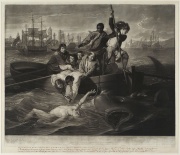Difference between revisions of "Mezzotint"
Jump to navigation
Jump to search
| Line 2: | Line 2: | ||
== Description == | == Description == | ||
| − | An | + | An intaglio process that was invented in the middle of the 17th century. A metal plate is prepared using a rocker to cover the entire surface with an even, toothy texture to hold ink. A design is drawn by smoothing out the burr with a burnisher. The burnished areas will hold less ink and appear lighter, whereas the untouched sections will print very dark. Mezzotints are characterized by a velvety matte surface. |
== Synonyms and Related Terms == | == Synonyms and Related Terms == | ||
Revision as of 12:48, 1 July 2014
Description
An intaglio process that was invented in the middle of the 17th century. A metal plate is prepared using a rocker to cover the entire surface with an even, toothy texture to hold ink. A design is drawn by smoothing out the burr with a burnisher. The burnished areas will hold less ink and appear lighter, whereas the untouched sections will print very dark. Mezzotints are characterized by a velvety matte surface.
Synonyms and Related Terms
black manner; mezzotint (Ned., Sven.); zwarte kunstprent (Ned.); manière noire (Fr.); Schabkunst (Deut.); Mezzotinto (Deut.); mezzatinta (It.); media tinta (Esp.)
Additional Information
Carol Wax, The Mezzotint: History and Technique. New York : H.N. Abrams, 1990
Authority
- Encyclopedia Britannica, http://www.britannica.com Comment: "Mezzotint." Encyclopædia Britannica. 23 Mar. 2004 .
- Website address 1 Comment: Multilingual Glossary for Art Librarians at http://www.ifla.org/VII/s30/pub/mgl.htm
- The Bullfinch Guide to Art History, Shearer West (ed.), Bullfinch Press, Boston, 1996

